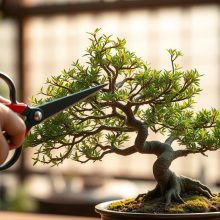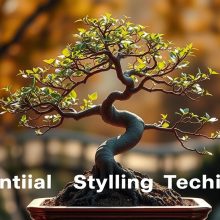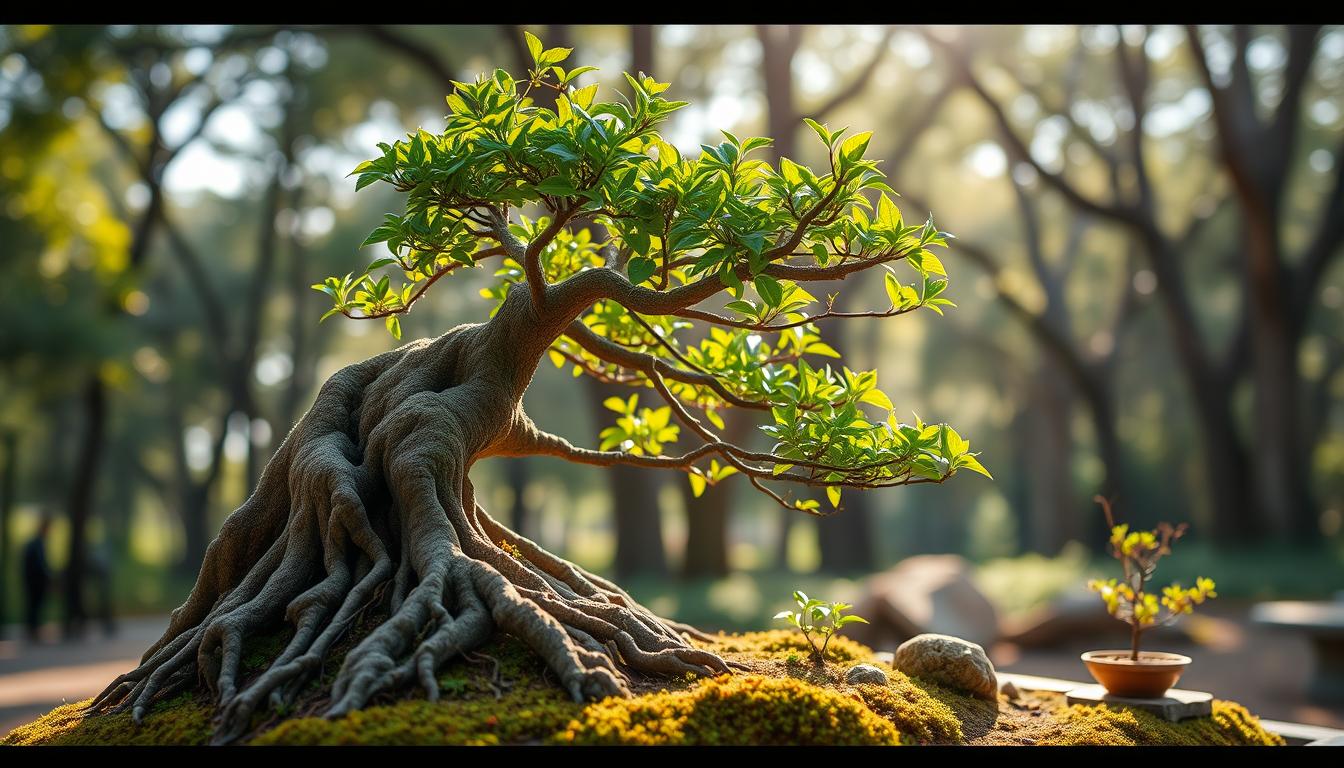How to Master Bonsai Pot Selection for Your Trees
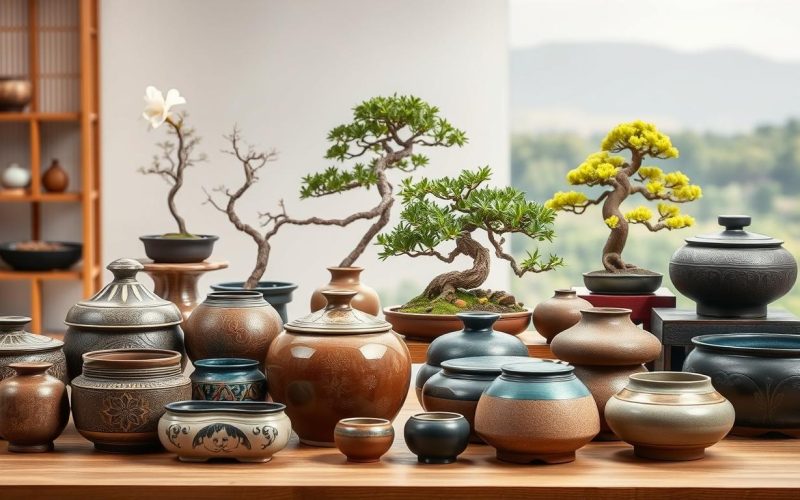
Choosing the right bonsai pot is key to turning a regular tree into a beautiful work of art. It’s not just about picking a container. It’s about creating the best space for your tree to grow and look its best.
For bonsai lovers, the pot is more than a container. It’s vital for the tree’s health and looks. The right pot can make your tree look amazing.
Experts in bonsai say picking the right pot is important. They consider things like drainage and how it looks. Each detail helps the tree grow well and look great.
Key Takeaways
- Bonsai pot selection impacts tree health and appearance
- Proper pot choice supports root development
- Aesthetic harmony is crucial in pot selection
- Drainage and size are critical considerations
- Material choice affects bonsai tree growth
Understanding the Importance of Bonsai Pot Selection
Choosing the right bonsai pot is key to growing healthy, beautiful miniature trees. The pot does more than just hold your bonsai. It affects the tree’s health, growth, and looks.
When picking a pot, consider several important factors. Different materials have unique benefits for growing bonsai trees. Each material impacts the tree’s environment and growth.
The Role of Potting in Bonsai Health
A good bonsai pot supports plant health in many ways:
- It gives roots the space they need to grow.
- It helps keep the right amount of moisture.
- It controls soil temperature and how nutrients are absorbed.
- It helps the tree stay stable and grow well.
Aesthetics and Functionality in Pot Design
Choosing a bonsai pot is not just about function. The right pot should match your tree’s look, creating a beautiful balance. Experts know that the right pot can make a tree look even more stunning.
When picking a pot, think about:
- How long it will last.
- How well it lets roots breathe.
- What works best for your bonsai species.
- How it looks with your tree.
Whether you pick ceramic, plastic, or something else, your choice should meet your bonsai’s needs and enhance its beauty.
Types of Bonsai Pots: An Overview
Choosing the right pot is key for your bonsai’s health and look. Each material has its own benefits and challenges.
Bonsai lovers have many pot options. Each one has its own perks and downsides for growing bonsai trees.
Ceramic Bonsai Pots: Traditional Elegance
Ceramic pots are the classic choice for bonsai trees. Made from stoneware, they are durable and beautiful.
- Excellent water drainage properties
- Provides natural temperature regulation
- Available in multiple colors and designs
- Long-lasting compared to other pot materials
Plastic Bonsai Pots: Modern Practicality
Plastic pots are a modern, affordable choice. They’re great for beginners and offer practical growing solutions.
- Lightweight and easy to handle
- Less expensive than ceramic options
- Resistant to cracking
- Ideal for training younger bonsai trees
Wooden Bonsai Pots: Natural Charm
Wooden pots add a natural touch to bonsai care. They create a rustic look that suits some trees well.
- Organic appearance
- Good moisture retention
- Suitable for specific tree types
- Requires periodic maintenance
Knowing what each pot material offers helps bonsai fans choose the best for their tree.
Factors to Consider in Pot Size Selection
Choosing the right pot size is key for your bonsai tree’s health and growth. Bonsai lovers need to think about many things to help their trees grow well and look great.
When picking a pot, there are a few important things to keep in mind. The pot should be about the same width as the trunk at the roots. This makes the tree look balanced and right.
Impact on Root Growth
Root growth depends a lot on the pot size and depth. A pot that’s too small can stop roots from growing. On the other hand, a pot that’s too big can hold too much water. Bonsai trees need the right pot size to have healthy roots.
- Measure trunk width at the base
- Choose pot depth proportional to tree height
- Allow adequate space for root expansion
Drainage Considerations
Drainage holes are very important for keeping the right amount of moisture in the soil. They help prevent water from staying too long and causing root rot. Make sure the pot has enough holes for the tree’s health.
Height vs. Width Ratios
Experts say there are certain ratios to follow for pot size. Oval and rectangular pots should be about two-thirds the tree’s height. This helps the tree and pot look good together.
- Rectangular pots: 2/3 tree height
- Oval pots: Maintain similar proportions
- Round pots: Adjust based on tree style
By thinking about pot size, depth, and drainage holes, bonsai fans can help their trees grow strong and look beautiful.
Shapes of Bonsai Pots and Their Uses
Choosing the right pot style is key for bonsai lovers. The pot’s shape is vital for showing off the tree’s beauty and helping it grow. The right pot can make a bonsai look better and stay healthy.
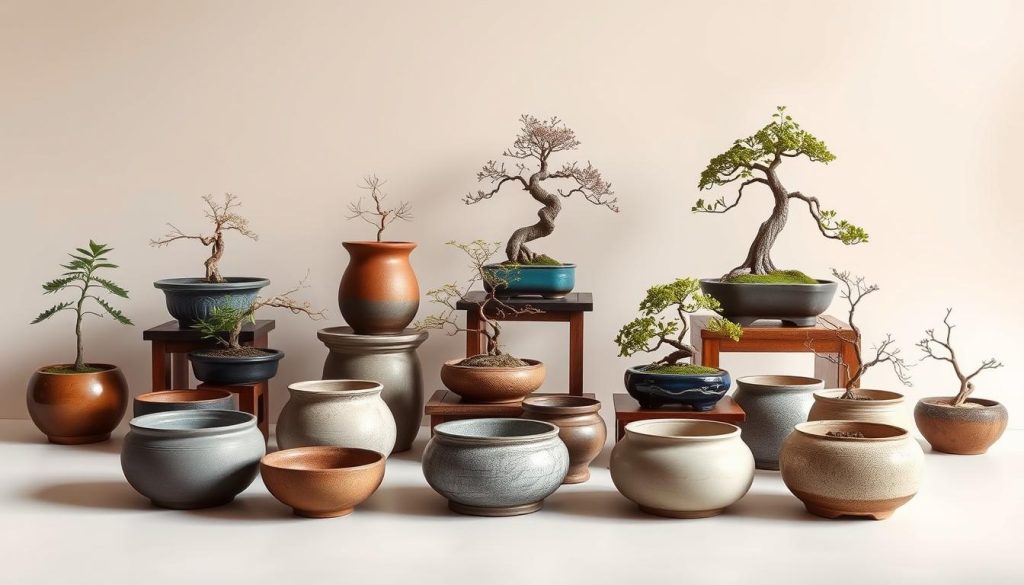
Bonsai pots come in many styles, from traditional to modern. Each style has its own purpose in growing trees. Knowing these styles helps create beautiful displays that show off the tree’s special features.
Round Pots: A Versatile Choice
Round pots are very versatile in bonsai growing. They fit well with many tree types, providing a simple background that complements different bonsai shapes. The benefits include:
- Smooth, continuous lines that create visual balance
- Suitable for both formal and informal tree designs
- Excellent for trees with curved or soft branch structures
Rectangular and Square Pots: Structured Elegance
Rectangular and square pots add structure and formality to bonsai displays. These shapes are great for trees with straight or symmetrical branches. They are best for:
- Coniferous trees with straight, defined branches
- Formal upright bonsai compositions
- Traditional Japanese bonsai presentations
Special Shapes for Unique Trees
Some bonsai trees need special pots to show off their unique traits. Cascading trees might need deeper pots, while unusual shapes can match specific trunk formations. Choosing the right pot is an art that requires thinking about the tree’s special qualities.
Bonsai Pot Materials: What to Choose?
Choosing the right pot material is key for your bonsai tree’s health and looks. Each material has its own benefits that can affect your bonsai’s growth and looks.
Bonsai lovers often pick between clay and plastic pots. Both have their own perks for growing bonsai trees.
Clay vs. Plastic: Pros and Cons
- Clay Pots:
- Great for root systems’ breathability
- Helps regulate moisture naturally
- Heavier, more stable
- Keeps temperature better
- Plastic Pots:
- Light, affordable
- Easier to move around
- Less likely to break than clay
- Keeps moisture better
Glazed vs. Unglazed Bonsai Pots
Glazed pots add color and smoothness, enhancing your bonsai’s look. They also protect the tree. Unglazed pots, made from natural clay, let air and moisture in, which is good for the roots.
Experts say to think about your tree type and local weather when picking pots. The right pot can greatly improve your bonsai’s growth and looks.
Visual Harmony: Matching Pots to Trees
Finding the right pot for your bonsai is more than just a practical choice. The perfect pot color and style can turn your bonsai into a stunning work of art.
To achieve harmony between your bonsai and its pot, think carefully about a few important things. The pot should match the tree’s natural look, creating a balanced and beautiful scene.
Color Coordination Principles
When picking a pot color, keep these tips in mind:
- Match the pot color to the tree’s bark or leaf color
- Choose neutral colors like brown, gray, or muted greens
- Use color to bring out your bonsai’s special features
Texture and Design Considerations
The style of the pot is key in showing off your bonsai’s beauty. Different textures can either add to or take away from the tree’s natural charm.
- Smooth ceramic pots are good for trees with rough bark
- Textured pots are better for trees with delicate leaves
- Think about the pot’s weight and how it balances the tree
Experts say to pick a pot that makes your bonsai and its container look great together. The aim is to create a visual conversation that highlights the tree’s natural beauty.
Seasonal Considerations for Pot Selection
Bonsai pot selection is a delicate art that needs careful attention to seasonal changes. Each season brings its own challenges and opportunities for bonsai care. Timing is key for successful pot management.
Understanding how seasons affect your tree’s growth and potting needs is crucial. Different seasons require specific approaches to bonsai pot selection and care.
Best Time of Year for Repotting
Spring is the best time for repotting most bonsai trees. Trees are ready for new growth, making them more adaptable to transplanting. When choosing pots in spring, consider:
- Timing repotting before new buds emerge
- Checking root health after winter dormancy
- Selecting pots that support upcoming growth cycles
Impact of Seasonal Changes on Potting
Seasonal changes greatly affect bonsai pot needs. Summer pots need good drainage, while winter pots protect roots. Bonsai pot selection must adapt to these changes.
- Summer: Choose pots with increased ventilation
- Winter: Select containers with thermal protection
- Fall: Prepare pots for tree’s dormancy period
Knowing these seasonal changes helps bonsai lovers make better pot choices. This ensures their trees stay healthy and vibrant all year.
Drainage Solutions for Bonsai Pots
Drainage is crucial for bonsai trees’ health. Drainage holes help keep the right balance of moisture and oxygen for roots. Without them, bonsai trees can get root rot and other serious problems.
Knowing about drainage holes can make a big difference in growing bonsai trees. The right drainage keeps your trees looking great and strong.
Importance of Proper Drainage
Good drainage stops many problems for bonsai trees:
- It keeps roots from drowning in water
- It stops soil from getting too tight
- It lowers the chance of fungal diseases
- It helps roots grow well
Types of Drainage Holes and Screens
When picking bonsai pots, look at these drainage hole features:
- Size: Holes need to be big enough for water to flow out fast
- Placement: Having more holes helps water spread out better
- Screens: Use mesh screens to keep soil in while letting water out
Bonsai experts say to check drainage holes often. Make sure they’re clear. A good drainage system is essential for your bonsai’s health and long life.
Preparing Your Bonsai Pot for Planting
Choosing the right bonsai pot is just the start. You also need to prepare it well for your tree’s health. This preparation helps your tree grow well and stay disease-free.
Before you plant, there are key steps to take. Cleaning and sterilizing your pot are important steps many miss.
Cleaning and Sterilizing Your Bonsai Pot
- Rinse the pot with warm water
- Use a soft brush to clean out dirt
- Soak in a mild bleach solution (1 part bleach to 10 parts water)
- Rinse well to get rid of bleach
- Let the pot dry completely
Layering Techniques for Optimal Drainage
Drainage is key in bonsai pot selection. The right soil layers help your bonsai’s roots and prevent water problems.
- Start with coarse drainage material
- Add a mesh screen over holes
- Mix akadama, pumice, and organic soil
- Make sure layers are loose but hold roots well
Choosing a bonsai pot needs careful thought. Clean and layer your pot well for a great home for your bonsai tree.
Custom vs. Pre-made Bonsai Pots: Pros and Cons
Choosing the right ceramic bonsai pots is a big decision for bonsai lovers. You must decide between custom and pre-made pots. This choice affects your bonsai’s look and health.
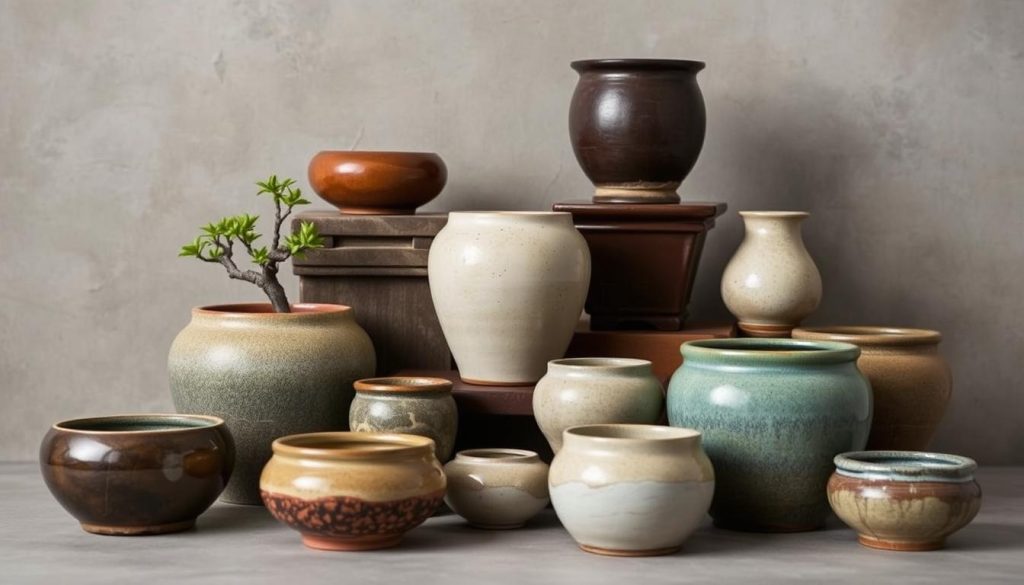
When picking bonsai pots, think about many things. Pre-made pots are great for both new and seasoned gardeners.
Advantages of Customization
- Perfect size matching for specific tree species
- Unique design tailored to individual aesthetic preferences
- Specialized features for particular bonsai types
- Precise drainage and root space optimization
Cost vs. Convenience of Pre-made Options
Pre-made ceramic bonsai pots have big benefits:
- Immediate availability
- Lower cost compared to custom designs
- Wide range of standard sizes and styles
- Quick replacement when needed
When choosing between custom and pre-made pots, consider your budget, style, and tree needs. Custom pots offer unique designs, while pre-made ones are cheaper and quicker to find.
The best choice depends on your needs, experience, and your bonsai’s characteristics. Talking to bonsai experts can help you make the best choice for your collection.
Caring for Your Bonsai Pot
Keeping your bonsai pot in good shape is key to your tree’s health. It helps keep your plant safe and looking great. This care is essential for your bonsai’s well-being.
Choosing the right bonsai pot is just the start. You also need to take care of it to keep your bonsai healthy and thriving.
Regular Cleaning Techniques
- Remove surface algae using a soft brush
- Rinse pots with clean water after cleaning
- Avoid harsh chemical cleaners that might damage pot surfaces
- Use gentle cleaning solutions specific to your pot material
Inspection for Damage and Wear
Checking your bonsai pot regularly is important. It helps spot problems before they get worse. Always inspect your pot during repotting.
- Check for hairline cracks or chips
- Verify drainage holes remain clear and unobstructed
- Look for signs of mineral buildup or discoloration
- Assess the overall structural integrity of the pot
Choosing and caring for your bonsai pot needs careful attention. By following these steps, you’ll ensure your bonsai stays healthy and beautiful.
Trends in Bonsai Pot Design
The world of bonsai pot style has seen big changes lately. Today, designers are mixing art with practical design in new ways. This means bonsai lovers can find pots that look modern and cool.
- Minimalist ceramic pots with clean lines
- Unconventional geometric shapes
- Bold color palettes breaking traditional constraints
- Asymmetrical designs challenging classic pot styles
Contemporary Styles
Modern pots focus on being simple yet eye-catching. Designers are trying out new materials and shapes that match different bonsai types. Pots with sleek designs and calm colors are loved by city bonsai fans.
Eco-Friendly Material Innovations
Now, making pots that are good for the planet is key. Creators are using recycled plastics, green ceramics, and eco-friendly tech. These choices help the environment and offer strong, light pots for bonsai lovers.
- Recycled plastic pot collections
- Biodegradable ceramic alternatives
- Sustainable manufacturing processes
The change in bonsai pot design shows how culture is moving towards simplicity, green living, and creativity. Bonsai fans can now display their trees in pots that are both useful and beautiful.
Common Mistakes in Bonsai Pot Selection
Choosing the right pot for your bonsai tree can be tricky. Many people make mistakes that hurt their tree’s health and growth. Knowing these common errors can help you pick better pots for your bonsai collection.
When picking a pot for your bonsai, you need to be careful. Two big mistakes can stop your tree from growing well:
Overestimating Pot Size Risks
It might seem smart to choose a big pot, but it’s not always the best choice. Large pots can cause problems:
- Too much soil holds too much water
- Roots have a hard time growing
- Nutrients don’t spread evenly
- Root rot is a big risk
Neglecting Drainage Holes
Drainage holes are key for your bonsai tree’s health. Without them, your tree can face serious root problems. When picking a pot, remember these drainage tips:
- Make sure there are many drainage holes at the bottom
- Check if the hole size fits your tree’s roots
- Ensure holes don’t let water stay
- Use mesh screens to keep holes open
Experts say to choose pot sizes that fit your tree’s roots well. The right pot size and drainage holes are essential for a healthy bonsai tree.
Resources for Bonsai Pot Selection
Learning about bonsai pot selection is a journey. There are many resources to help you grow your skills. Books on bonsai care give detailed advice on picking the right pot.
Online communities are also a great help. Sites like Bonsai Empire and Reddit’s r/Bonsai forum connect people worldwide. Here, you can share your experiences, ask questions, and get tips on choosing the best pot for your tree.
Essential Books for Bonsai Care
There are key books to learn from. “The Complete Book of Bonsai” by Harry Tomlinson and “Bonsai: The Art of Growing and Keeping Miniature Trees” by Peter Chan are top picks. They dive deep into pot materials, sizes, and looks for the best bonsai growth.
Online Forums and Learning Platforms
Digital tools have changed bonsai learning. Sites like Bonsai Tonight and International Bonsai Magazine have lots of tutorials and talks on pot selection. By joining these groups, you can improve your skills and keep up with new trends in bonsai pots.
